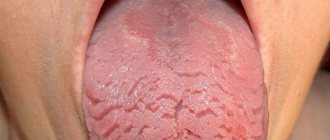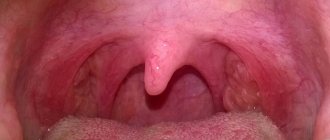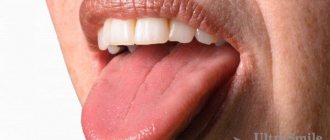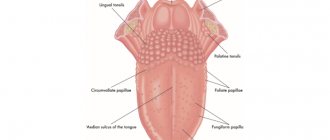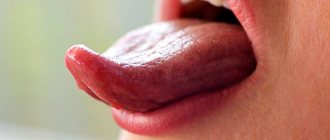Glossitis: symptoms and treatment in adults
Contents:
What is glossitis
Symptoms of glossitis
Causes of glossitis in adults
Types of glossitis in adults
How and with what to treat glossitis in adults
Prevention of glossitis
Doctor's advice
Answers on questions
There are many factors that lead to pathologies in the oral cavity. Glossitis - what is it? This is a term that combines various diseases of the tongue.
Symptoms and treatment of glossitis
If you suspect glossitis, we recommend that you immediately consult a dentist. It is usually diagnosed visually, but is often associated with other diseases, the detection of which requires a series of tests.
Note!
Treatment of glossitis in a child is carried out using the same methods, but the doctor prescribes antibiotics and drugs that are more suitable for the child’s body and do not harm it.
Symptoms and treatment of desquamative glossitis
With this type of glossitis, patients experience a symptom called “geographic tongue.” Reddish spots of irregular shape appear on the tongue, framed by a white coating, resembling a geographical map. This type of glossitis is often associated with diseases of the internal organs.
Treatment of desquamative glossitis is aimed at reducing the risks of exacerbation of the disease, since most often this type is chronic. The tongue is treated with anti-inflammatory gels and solutions (chlorophyllipt solution, carotoline, etc.). For severe pain, novocaine blockades are prescribed. Phonophoresis procedures are actively used. It is recommended to follow a diet and take B vitamins.
Symptoms and treatment of folded glossitis
Folded glossitis is distinguished by deep longitudinal and transverse grooves in the tongue. As a rule, this type is congenital, but can be acquired as a result of injuries, burns and infections. Often accompanied by desquamative glossitis. Treatment is carried out if there is a burning sensation, pain and difficulty breathing.
In the absence of inflammation and discomfort, treatment is not carried out. If the patient is bothered by pain and burning, then antiseptic solutions (in particular, chlorhexidine) and anti-allergenic agents (if there are allergies to foods) are used. Doctors also advise against eating too spicy or salty foods.
Symptoms and treatment of catarrhal glossitis
It is characterized by swelling, redness and a white coating on the surface of the tongue. Usually occurs as a result of mechanical, thermal and chemical damage.
Treatment with antiseptic and anti-inflammatory agents is used (especially if the cause of glossitis is trauma), nutrition correction and vitamin intake are also useful.
Symptoms and treatment of candidal (mycotic, or yeast) glossitis
Can be distinguished by a thick layer of plaque on the tongue and an unpleasant odor. As a rule, it does not cause pain or great discomfort, but occurs due to poor hygiene and disruption of the microflora of the oral cavity.
Treatment of candidal glossitis (also known as mycotic and yeast) is carried out with the aim of normalizing the microflora of the oral cavity. First of all, this is sanitation and taking antifungal drugs (Fluconazole, Nystatin and others).
Symptoms and treatment of rhomboid glossitis
It is often one of the manifestations of diseases of the gastrointestinal tract. With rhomboid glossitis of the tongue, the layer of epithelium thickens in a certain area, which in its shape resembles a rhombus or rectangle. In most cases, the disease is accompanied by the appearance of plaque.
Rhomboid glossitis is usually a consequence of problems with the gastrointestinal tract. Effective treatment requires elimination of the underlying disease. For severe pain, anesthetics are prescribed.
Symptoms and treatment of ulcerative glossitis
Identified by small round ulcers on the surface of the tongue - aphthae. Ulcerative glossitis is often associated with aphthous stomatitis and may be one of the stages of catarrhal glossitis.
Treatment usually follows the same scheme as for catarrhal glossitis. Ointments and gels are prescribed separately for faster healing of ulcers (Solcoseryl, Vinizol, etc.)
Symptoms and treatment of purulent-phlegmous glossitis
It affects the deep tissues of the tongue and adjacent areas of the oral cavity. One of the most severe forms, in which the temperature rises and intoxication of the body is observed.
In this form, glossitis is most often treated with antibiotics (Doxycycline, Ceftriaxone, Rocephin and others). In severe cases, surgery may be required. It is necessary to monitor the course of the disease after antibiotics. Treatment is usually aimed at restoring the body after taking the above-mentioned drugs. Antibacterial therapy is actively used.
Symptoms and treatment of Gunter's glossitis
Möller-Gunter glossitis usually occurs as a manifestation of serious problems with the circulatory system, in particular anemia. The surface of the tongue becomes smooth and has an unhealthy bright red or crimson color. May also be associated with vitamin B12 deficiency.
Indications are primarily for the treatment of anemia and the intake of vitamin B12.
Symptoms and treatment of villous glossitis
The most unpleasant form of the disease. The filiform papillae become thickened and keratinized and the surface of the tongue changes color (becomes dark brown).
This type of glossitis is the least studied, and the exact causes of its occurrence have not been determined. Among other things, experts name genetic predisposition, infections, medications and bad habits.
Indications: surgical excision of hypertrophied and keratinized filiform papillae, treatment of the surface of the tongue with antiseptic and antimicrobial agents (resorcinol, salicylic alcohol, etc.).
Symptoms of glossitis:
- pain when eating and moving the tongue;
- difficulty moving;
- color change, plaque appearance;
- swelling of the mucous membrane;
- deformation;
- loss of taste sensitivity (partial or complete);
- sensation of a lump in the throat, a foreign object in the oral cavity;
- the appearance of solid formations and compactions.
If these symptoms are detected, you should immediately contact dentistry in Moscow to avoid complications or the disease developing into chronic glossitis.
General symptoms of glossitis
The first signs of inflammation of the tongue are discomfort, burning and the sensation of a foreign body in the mouth. Subsequently, the tongue noticeably swells and acquires a burgundy or scarlet hue. The symptomatic picture of the disease may include:
- increased salivation;
- dullness or complete loss of taste;
- perversion of taste;
- pain and difficulty eating;
- slurred speech;
- the patient's desire not to use the tongue when creating sounds.
Symptoms of chronic glossitis
Chronic glossitis is characterized by persistent swelling and changes in the structure of the tissues of the tongue. With bacterial inflammation, hyperemia, soreness, swelling of the affected area and a local increase in temperature can be observed. The development of glossitis, which is of viral origin, is accompanied by the appearance of small blisters on the surface of the tongue, which eventually open and form painful erosions. The disease, which is of a fungal nature, is manifested by the appearance of a dense or loose white coating on the affected surface, as well as hyperplastic changes in tissue.
Causes of glossitis in adults
There are many factors that lead to the occurrence of this pathology:
- infectious factor (viruses, bacteria, fungi);
- inflammatory gum diseases (periodontitis, gingivitis), carious teeth;
- poor oral hygiene;
- thermal, chemical burns;
- injury to the tongue with sharp objects, including sharp edges of fillings and dentures;
- smoking;
- reduced immunity.
Most often, patients have several factors that lead to
Types of glossitis in adults
- Interstitial glossitis - occurs with syphilis, often leads to cancerous tumors of the tongue
- Gunterovsky - the initial symptom of pernicious anemia, manifests itself in the form of smoothing of the surface.
- Diamond-shaped tongue is a developmental anomaly.
- Folded is a congenital developmental anomaly.
- Hairy tongue - severe keratinization of filiform papillae, resulting in a black coating.
- Geographic (folded) - noticeable red spots, furrows.
- Ulcerative – bleeding ulcers and bad breath are observed.
- Catarrhal - a white dense coating covers the entire surface of the muscle.
Do not self-medicate, consult a doctor!
Don't wait for your condition to worsen!
Sign up
Types of glossitis
In modern dental practice, it is customary to distinguish the following forms of glossitis:
- deep;
- desquamative;
- diamond-shaped;
- villous;
- folded;
- Gunter's;
- interstitial.
Deep glossitis
Deep glossitis is characterized by the occurrence of an inflammatory process at the bottom of the mouth and its gradual spread to the neck and chin. In most cases, the clinical picture of the disease is complemented by the formation of abscesses.
Desquamative glossitis
Desquamative glossitis is detected in pregnant women and people suffering from chronic gastrointestinal diseases, parasitic pathologies, liver diseases, blood diseases and metabolic disorders. The development of the inflammatory process is based on focal destruction of epithelial tissue, so its main symptoms are bright red spots, lines and furrows on the surface of the tongue.
Diamond-shaped glossitis
Diamond-shaped glossitis occurs against the background of gastritis with low acidity and other gastrointestinal diseases. Clinically, this form of the disease is manifested by the formation of bright red or bluish diamond-shaped areas in the root zone of the tongue. In some cases, the affected surface may atrophy, become covered with dense bumpy growths or hyperplastic growths.
Villous glossitis
Villous glossitis is characterized by elongation and keratinization of the papillae of the tongue. The risk group for this pathology includes smokers, as well as people suffering from candidiasis and using medications for a long time.
Folded glossitis
Folded glossitis is manifested by the appearance of painless folds on the back of the tongue. This form of pathology is congenital and requires treatment only for aesthetic reasons.
Gunter's glossitis
Gunter's glossitis occurs against the background of anemia caused by a deficiency of vitamin B12 in the body. In this case, the surface of the tongue acquires a bright crimson color, becomes smooth and shiny.
Interstitial glossitis
Interstitial glossitis is characterized by the replacement of part of the muscle tissue of the tongue with connective tissue and is one of the signs of syphilis of the tertiary period. This form of the disease is considered a precancerous condition in the patient and requires urgent treatment.
Answers on questions
What diagnostics are carried out before treatment?
The dentist examines the patient, collects medical history data: complaints, data on the patient’s general health (presence of chronic diseases). If necessary, laboratory diagnostics are prescribed: a smear (culture) from the oral cavity for microflora.
How to treat hairy tongue in adults?
The doctor prescribes complete sanitation of the oral cavity: removal of stone, plaque, and carious teeth. Selects individual home hygiene products. Prescribes a diet that includes plenty of fluids and solid vegetables. Smoking is prohibited. If necessary, the dentist prescribes rinsing solutions and antibacterial agents.
Treatment of glossitis
The treatment of glossitis is based on the correction of underlying diseases and the elimination of factors that provoke the occurrence of the inflammatory process. In addition, the therapy program includes:
- adherence to a diet that includes the inclusion of various purees, slimy porridges and pureed soups in the patient’s diet;
- rinsing the mouth with solutions of furatsilin or chlorhexidine;
- applications with solutions of pyromecaine, trimecaine, lidocaine and other anesthetics;
- relieving signs of dry tongue using a mixture of glycerin and anesthesin;
- accelerating the process of regeneration of affected tissues using drugs made on the basis of solcoseryl and vitamin A;
- surgical intervention (in the presence of pronounced hyperkeratic changes).
It is important to know that with timely and competent treatment, inflammatory lesions of the tongue can be easily corrected. An unfavorable outcome of the disease, characterized by the development of abscesses, cellulitis and cancer, is observed only in the absence of adequate therapy.
